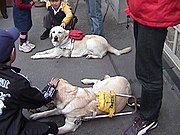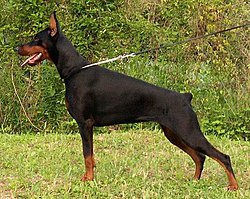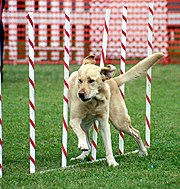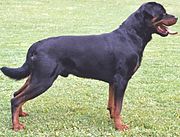
The
Labrador Retriever (also
Labrador, or
Lab for short) is one of several kinds of
retriever, a type of
gun dog. The Labrador, once known as the Lesser Newfoundland, is the most popular
breed of
dog (by registered ownership) in the world, and is by a large margin the most popular breed by registration in
Canada, the
United States (since 1991),
and the
United Kingdom.
It is also the most popular breed of
assistance dog in Canada, the United States,
Australia,
United Kingdom and many other countries, as well as being widely used by police and other official bodies for their detection and working abilities.
Description

A black Labrador from English stock.
Appearance
Labradors are relatively large, with males typically weighing 29-41 kg (65-90 pounds) and females 25–32 kg (55–71 lb). Labs weighing close to or over 100 lbs are considered obese or having a major fault under American Kennel Club standards, although some labs weigh significantly more. The majority of the characteristics of this breed, with the exception of colour, are the result of breeding to produce a working retriever.
As with some other breeds, the Conformation (typically "English", "show" or "bench") and the Field (typically "American" or "working") lines differ, although both lines are bred in both countries. In general, however, Conformation Labs tend to be bred as medium-sized dogs, shorter and stockier with fuller faces and a slightly calmer nature than their Field counterparts, which are often bred as taller, lighter-framed dogs, with slightly less broad faces and a slightly longer nose; however Field labs should still be proportional and fit within AKC standards. With field labs, excessively long noses, thin heads, long legs and lanky frames are not considered standard. These two types are informal and not codified or standardised; no distinction is made by the AKC or other kennel clubs, but the two types come from different breeding lines. Australian stock also exists; though not seen in the west, they are common in Asia.
The breed tends to shed hair twice annually, or regularly throughout the year in temperate climates. Some labs shed a lot; however, individual labs vary. Labrador hair is usually fairly short and straight, and the tail quite broad and strong. The otter-like tail and webbed toes of the Labrador Retriever make them excellent swimmers. Their interwoven coat is also relatively waterproof, providing more assistance for swimming.
Official breed standards
Like any animal, there is a great deal of variety among Labs. The following characteristics are typical of the conformation show bred (bench-bred) lines of this breed in the United States, and are based on the AKC standard. Significant differences between US and UK standards are noted.
- Size: Labs are a medium-large but compact breed. They should have an appearance of proportionality. They should be as long from the withers to the base of the tail as they are from the floor to the withers. Males should stand 22.5–24.5 inches (57–62 cm) tall at the withers and weigh 65–80 lb (29–36 kg). Females should stand 21.5–23.5 inches (55–60 cm) and weigh 55–70 lb (25–32 kg). By comparison under UK Kennel Club standards, height should be 22–22.5 inches (56–57 cm) for males, and 21.5–22 inches (55–56 cm) for females.
- Coat: The Lab's coat should be short and dense, but not wiry. The coat is described as 'water-resistant' or more accurately 'water-repellent' so that the dog does not get cold when taking to water in the winter. That means that the dog naturally has a slightly dry, oily coat. Acceptable colours are black, yellow (ranging fom ivory or creme to fox red), and chocolate.
- Head: The head should be broad with a pronounced stop and slightly pronounced brow. The eyes should be kind and expressive. Appropriate eye colours are brown and hazel. The lining around the eyes should be black. The ears should hang close to the head and are set slightly above the eyes.
- Jaws: The jaws should be strong and powerful. The muzzle should be of medium length, and should not be too tapered. The jaws should hang slightly and curve gracefully back.
- Body: The body should be strong and muscular with a level top line.
The tail and coat are designated "distinctive [or distinguishing] features" of the Labrador by both the Kennel Club and AKC. The AKC adds that "true Labrador Retriever temperament is as much a hallmark of the breed as the 'otter' tail."
As well, Labradors should not have droopy eyes (like a Basset Hound). The skin should be relatively tight, and you should not be able to see the pinks on the inside of their lids.
Color

Different shades of yellow: a usual yellow shade, and a fox red shade.

The three primary colour varieties of the Labrador Retriever
There are four colors for Labs: black (a solid black colour), yellow (anything from light cream to gold to "fox-red"), silver (light gray to charcoal), and chocolate (medium to dark brown). The silver color has been heavily disputed. The AKC has accepted and registered silver labs. They are however, registered as chocolate since the chocolate color can range from Sedge to Chocolate. The breed standard states that a Labrador must be of one solid color. There is also a black-and-tan coat type, but this coat color is the least popular as it renders the Labrador un-showable except in the UK.
Puppies of all colors can potentially occur in the same litter. Color is determined primarily by two genes. The first gene (the B locus) determines the density of the coat's pigment granules: dense granules result in a black coat, sparse ones give a chocolate coat. The second (E) locus determines whether the pigment is produced at all. A dog with the recessive e allele will produce little pigment and will be yellow regardless of its genotype at the B locus. Variations in numerous other genes control the subtler details of the coat's colouration, which in yellow Labs varies from white to light gold to a fox red. Chocolate and black Labs' noses will match the coat colour.
Nose and skin pigmentation
Because Labrador coloration is controlled by multiple genes, it is possible for recessive genes to emerge some generations later and also there can sometimes be unexpected pigmentation effects to different parts of the body. Pigmentation effects appear in regard to yellow Labradors, and sometimes chocolate, and hence the majority of this section covers pigmentation within the yellow Labrador. The most common places where pigmentation is visible are the nose, lips, gums, feet, tail, and the rims of the eyes, which may be black, brown, light yellow-brown ("liver", caused by having two genes for chocolate), or several other colours. A Labrador can carry genes for a different colour, for example a black Labrador can carry recessive chocolate and yellow genes, and a yellow Labrador can carry recessive genes for the other two colours. DNA testing can reveal some aspects of these. Less common pigmentations (other than pink) are a fault, not a disqualification, and hence such dogs are still permitted to be shown. The intensity of black pigment on yellow Labs is controlled by a separate gene independent of the fur colouring. Yellow Labradors usually have black noses, which may gradually turn pink with age (called "snow nose" or "winter nose"). This is due to a reduction in the enzyme tyrosinase which indirectly controls the production of melanin, a dark colouring. Tyrosinase is temperature dependent—hence light colouration can be seasonal, due to cold weather—and is less produced with increasing age two years old onwards. As a result, the nose colour of most yellow Labs becomes a somewhat pink shade as they grow older.

A seven-week-old Dudley Lab. The nose and lips are pink or flesh-coloured, the defining aspect of Dudley pigmentation.
A colouration known as "Dudley" is also possible. Dudleys are variously defined as yellow Labs which have no pigmented (pink) noses (LRC), yellow with liver/chocolate pigmentation (AKC), or "flesh coloured" in addition to having the same colour around the rims of the eye, rather than having black or dark brown pigmentation. A yellow Labrador with brown or chocolate pigmentation, for example, a brown or chocolate nose, is not necessarily a Dudley, though according to the AKC's current standard it would be if it has chocolate rims around the eyes (or more accurately of the genotype eebb). Breed standards for Labradors considers a true Dudley to be a disqualifying feature in a conformation show Lab, such as one with a thoroughly pink nose or one lacking in any pigment along with flesh coloured rims around the eyes. True Dudleys are extremely rare.
Breeding in order to correct pigmentation often lacks dependability. Because colour is determined by many genes, some of which are recessive, crossbreeding a pigmentation non-standard yellow Labrador to a black Labrador may not correct the matter or prevent future generations carrying the same recessive genes. For similar reasons, crossbreeding chocolate to yellow labs is also often avoided.
Show and field lines

Chocolate Labradors from field-bred stock are typically lighter in build and have a shorter coat than conformation show Labrador.
There are significant differences between field and trial-bred (sometimes referred to as "American") and show-bred (or "English") lines of Labradors, arising as a result of specialised breeding. Dogs bred for hunting and field-trial work are selected first for working ability, where dogs bred to compete in conformation shows are selected for their conformation to the standards and characteristics sought by judges in the show ring.

Head and muzzle appearance: American or field (left), and English or show (right), showing the shorter muzzle length, more solid appearance head, and "pronounced" stop of the latter.
While individual dogs may vary, in general show-bred Labradors are heavier built, slightly shorter-bodied, and have a thicker coat and tail. Field Labradors are generally longer legged, lighter, and more lithe in build. In the head, show Labradors tend to have broader heads, better defined stops, and more powerful necks, while field Labradors have lighter and slightly narrower heads with longer muzzles. Field-bred Labradors are commonly higher energy and more high-strung compared to the Labrador bred for conformation showing, and as a consequence may be more suited to working relationships than being a "family pet". Some breeders, especially those specialising in the field type, feel that breed shows do not adequately recognise their type of dog, leading to occasional debate regarding officially splitting the breed into subtypes.
In the United States, the AKC and the Labrador's breed club have set the breed standard to accommodate the field-bred Labrador somewhat. For instance, the AKC withers-height standards allow conformation dogs to be slightly taller than the equivalent British standard.However, dual champions, or dogs that excel in both the field and the show ring, are becoming more unusual.
Temperament
Labradors are a well-balanced, friendly and versatile breed, adaptable to a wide range of functions as well as making very good pets. As a rule they are not excessively prone to being territorial, pining, insecure, aggressive, destructive, hypersensitive, or other difficult traits which sometimes manifest in a variety of breeds, and as the name suggests, they are excellent retrievers. As an extension of this, they instinctively enjoy holding objects and even hands or arms in their mouths, which they can do with great gentleness (a Labrador can carry an egg in its mouth without breaking it). They are also known to have a very soft feel to the mouth, as a result of being bred to retrieve game such as waterfowl. They are prone to chewing objects (though they can be trained out of this behaviour). The Labrador Retriever's coat repels water to some extent, thus facilitating the extensive use of the dog in waterfowl hunting.

Labradors enjoy playing with water
Labradors have a reputation as a very mellow breed and an excellent family dog (including a good reputation with children of all ages and other animals), but some lines (particularly those that have continued to be bred specifically for their skills at working in the field rather than for their appearance) are particularly fast and athletic. Their fun-loving boisterousness and lack of fear may require training and firm handling at times to ensure it does not get out of hand—an uncontrolled adult can be quite problematic. Females may be slightly more independent than males. Labradors mature at around three years of age; before this time they can have a significant degree of puppyish energy, often mislabelled as being hyperactive. Because of their enthusiasm, leash-training early on is suggested to prevent pulling when full-grown. Labs often enjoy retrieving a ball endlessly and other forms of activity (such as agility, frisbee, or flyball). Reflecting their retrieving bloodlines, almost every Lab loves playing in water or swimming[citation needed].
Although they will sometimes bark at noise, especially noise from an unseen source ("alarm barking"), Labs are usually not noisy or territorial. They are often very easygoing and trusting with strangers, and therefore are not usually suitable as guard dogs.
Labradors have a well-known reputation for appetite, and some individuals may be highly indiscriminate, eating digestible and non-food objects alike. They are persuasive and persistent in requesting food. For this reason, the Labrador owner must carefully control his/her dog's food intake to avoid obesity and its associated health problems (see below).
The steady temperament of Labs and their ability to learn make them an ideal breed for search and rescue, detection, and therapy work. Their primary working role in the field continues to be that of a hunting retriever.
Exploration
They do not typically jump high fences or dig. Because of their personalities, some Labs climb and/or jump for their own amusement. As a breed they are highly intelligent and capable of intense single-mindedness and focus if motivated or their interest is caught. Therefore, with the right conditions and stimuli, a bored Labrador could "turn into an escape artist par excellence".
Labradors as a breed are curious, exploratory and love company, following both people and interesting scents for food, attention and novelty value. In this way, they can often "vanish" or otherwise become separated from their owners with little fanfare. They are also popular dogs if found, and at times may be stolen. Because of this a number of dog clubs and rescue organisations (including the UK's Kennel Club) consider it good practice that Labradors be microchipped, with the owner's name and address also on their collar and tags.
Use as working dogs

Labradors are a very popular selection for use as
guide dogs.
Labradors are an intelligent breed with a good work ethic and generally good temperaments (breed statistics show that 91.5% of Labradors who were tested passed the American Temperament Test.[32]) Common working roles for Labradors include: hunting, tracking and detection (they have a great sense of smell which helps when working in these areas), disabled-assistance, carting, and therapy work. Approximately 60–70% of all guide dogs in Canada are Labradors; other common breeds are Golden Retrievers and German Shepherd Dogs.
The high intelligence, initiative and self-direction of Labradors in working roles is evinced by individuals such as Endal, who during a 2001 emergency placed an unconscious human being in the recovery position without prior training, retrieved his mobile phone from beneath the car, fetched a blanket and covered him, barked at nearby dwellings for assistance, and then ran to a nearby hotel to obtain help. A number of labradors have also been taught to assist their owner in removing money and credit cards from ATMs with prior training.
Health and well-being

Many dogs, including Labs such as this twelve year old, show distinct whitening of the coat as they grow older; especially around the muzzle.
Labrador pups should not be brought home before they are 7–10 weeks old. Their life expectancy is generally 12 to 13 years,[37] and it is a healthy breed with relatively few major problems. Notable issues related to health and wellbeing include:
Inherited disorders
- Labs are somewhat prone to hip and elbow dysplasia, especially the larger dogs, though not as much as some other breeds. Hip scores are recommended before breeding.
- Labs also suffer from the risk of knee problems. A luxating patella is a common occurrence in the knee where the leg is often bow shaped.
- Eye problems are also possible in some Labs, particularly progressive retinal atrophy, cataracts, dystroph and retinal dysplasia. Dogs which are intended to be bred should be examined by a veterinary ophthalmologist for an eye score.
- Hereditary myopathy, a rare inherited disorder that causes a deficiency in type II muscle fibre.
- There is a small incidence of other conditions, such as autoimmune diseases and deafness in labs, either congenitally or later in life.
- Labradors often suffer from exercise induced collapse, a syndrome that causes hyperthermia, weakness, collapse, and disorientation after short bouts of exercise.
Other disorders
Labs are sometimes prone to ear infection, because their floppy ears trap warm moist air. This is easy to control, but needs regular checking to ensure that a problem is not building up unseen. A healthy Labrador ear should look clean and light pink (almost white) inside. Darker pink (or inflamed red), or brownish deposits, are a symptom of ear infection. The usual treatment is regular cleaning daily or twice daily (being careful not to force dirt into the sensitive inner ear) and sometimes medication (ear drops) for major cases. As a preventative measure, some owners clip the hair carefully around the ear and under the flap, to encourage better air flow. Labradors also get cases of allergic reactions to food or other environmental factors.
Obesity
Labs can easily become overweight, due to their enjoyment of treats, hearty appetites, and endearing behaviour towards people. Lack of activity is also a contributing factor. A healthy Labrador should keep a very slight hourglass waist and be fit and light, rather than fat or heavy-set. Excessive weight is strongly implicated as a risk factor in the later development of hip dysplasia or other joint problems and diabetes, and also can contribute to general reduced health when older. Osteoarthritis is common place in older, especially overweight, Labs. A 14 year study covering 48 dogs by food manufacturer Purina showed that labs fed to maintain a lean body shape outlived those fed freely, by around two years, emphasizing the importance of not over-feeding.
Appearance Around the World
In the United States, the breed gained wider recognition following a 1928 American Kennel Gazette article, "Meet the Labrador Retriever". Before this time, the AKC had only registered 23 Labradors in the country, in part because US and UK hunting styles had different requirements. Labradors acquired popularity as hunting dogs during the 1920s and especially after World War II, as they gained recognition as combining some of the best traits of the two favourite United States breeds as both game finders and water dogs.
Outside North America and Western Europe, the Labrador arrived later. For example, the Russian Retriever Club traces the arrival of Labradors to the late 1960s, as household pets of diplomats and others in the foreign ministry. The establishment of the breed in the Commonwealth of Independent States (ex-USSR) was initially hindered by the relatively small numbers of Labradors and great distances involved, leading to difficulty establishing breedings and bloodlines; at the start of the 1980s, home-born dogs were still regularly supplemented by further imports from overseas. Difficulties such as these initially led to Labradors being tacitly cross-bred to other types of retriever.In the 1990s, improved access to overseas shows and bloodlines is said to have helped this situation become regularised.
Demography
The Labrador is an exceptionally popular dog. For example as of 2006[update]:
-
- Widely considered the most popular breed in the world.
- Most popular dog by ownership in USA (since 1991), Australia, New Zealand Canada, and Israel.
- In both the UK and USA, there are well over twice as many Labradors registered as the next most popular breed. If the comparison is limited to dog breeds of a similar size, then there are around 3 - 5 times as many Labradors registered in both countries as the next most popular breeds, the German Shepherd and Golden Retriever.
- Most popular breed of assistance dog in the United States, Australia and many other countries, as well as being widely used by police and other official bodies for their detection and working abilities. Approximately 60–70% of all guide dogs in the United States are Labradors (see below).
- Seven out of 13 of the Australian National Kennel Council "Outstanding Gundogs" Hall of Fame appointees are Labradors (list covers 2000-2005).
There is no global registry of Labradors, nor detailed information on numbers of Labradors living in each country. The countries with the five largest numbers of Labrador registrations as of 2005 are: 1: United Kingdom 2: United States and France (approximately equal), 4: Sweden, 5: Finland. Sweden and Finland have far lower populations than the other three countries, suggesting that as of 2005[update] these two countries have the highest proportion of labs per million people:
Famous labradors
As both the most popular breed by registered ownership and also the most popular breed for assistance dogs in several countries, there have been many notable and famous labradors since the breed was recognised.
A selection of a few of the most famous labradors within various categories includes:
- Assistance dogs
- Endal, a service dog in England. Among other distinctions, "the most decorated dog in the world" (including "Dog of the Millennium" and the PDSA’s Gold Medal for Animal Gallantry and Devotion to Duty), the first dog to ride on the London Eye and the first dog known to work a 'chip and pin' ATM card. By Endal's death in March 2009, he and his owner/handler Allen Parton had been filmed almost 350 times by crews from several countries, and a film of a year in Endal's life was in production.
- Police, military, rescue and detection dogs
- Lucky and Flo, twin Black Labrador counterfeit detection dogs who became famous in 2007 for "sniffing out nearly 2 million pirated counterfeit DVDs" on a six-month secondment to Malaysia in 2007. Following the multi-million dollar, 6-arrest Malaysian detection, they became the first dogs to be awarded Malaysia's, "outstanding service award", and software pirates were stated to have put a £30,000 contract out for their lives.
- Pets
- Fiction and media
- Labradors have featured variously as pets and significant characters in sitcoms and other TV shows, as well as other portrayals in the media. Bouncer in Neighbours, and Luath in The Incredible Journey, are two TV examples.
- Marley is an American Labrador portrayed in Marley & Me, a book by John Grogan in which Grogan recounts his life and times with Marley.
- Mascots and advertising
Significant crossbreeds
The "Labradoodle" is a popular "designer dog" that is a cross-bred Labrador and Poodle. The original intent was to try and create a service dog suitable for allergy sufferers. However the fashionability of labradoodles has resulted in indescriminate breeding, and there is no guarantee a cross will inherit the hypo-allergenic poodle coat.
Some assistant-dog groups use Golden Retriever / Labrador Retriever hybrids (unofficially called a Golden Labrador Retriever) as they have found it can produce a dog with a more suitable temperament. It is important to use dogs from good stocks since crossbreeds are not immune to such problems and since Golden Retrievers and Labradors have similar health problems.
The assistance dog organization Mira utilises Labrador-Bernese Mountain Dog crosses ("Labernese") with success.
































